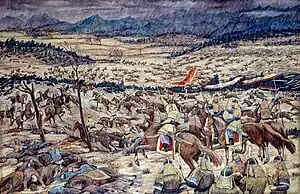| Battle of Kwiju | |||||||
|---|---|---|---|---|---|---|---|
| Part of Third Goryeo-Khitan War | |||||||
 Battle of Kwiju | |||||||
| |||||||
| Belligerents | |||||||
| Liao dynasty | Goryeo | ||||||
| Commanders and leaders | |||||||
| Xiao Paiya |
Kang Kamch'an[3] Kang Minch'ŏm Kim Chonghyŏn | ||||||
| Strength | |||||||
| 100,000[4] | 12,000[4] | ||||||
| Casualties and losses | |||||||
| 90,000+ | few thousand | ||||||
| Battle of Kuju | |||||||
|---|---|---|---|---|---|---|---|
| Traditional Chinese | 龜州大捷 | ||||||
| Simplified Chinese | 龟州大捷 | ||||||
| |||||||
| Battle of Kuju | |
| Hangul | 귀주대첩 or 구주대첩 |
|---|---|
| Hanja | 龜州大捷 |
| Revised Romanization | Gwiju Daecheop or Guju Daecheop |
| McCune–Reischauer | Kwiju Taech'ŏp or Kuju Taech'ŏp |
The Battle of Kwiju, also known as the Battle of Kuju, which occurred in 1019, was the major battle during the Third Goryeo–Khitan War (1018-1019), fought between the Khitan-led Liao dynasty of China and the Goryeo dynasty of Korea.
After crossing the Amnok River, the Liao dynasty troops invaded the Goryeo dynasty. The Goryeo general Kang Kam-ch'an dammed a stream and released it as the Liao troops were crossing. Despite suffering significant casualties, Liao troops marched to Gaegyeong, the capital of Goryeo.
During their campaign, general Kang Kam-ch'an cut the supplies of the Liao troops and harassed them relentlessly. Exhausted, the Liao troops decided to retreat hastily northward. Monitoring the movement of their troops, general Kang Kamch'an attacked them in the vicinity of Gwiju, ending in a complete victory for the Goryeo dynasty.[5]
Aftermath
After the battle, peace negotiations followed and the Liao dynasty did not invade Korea again.[3][6] Korea agreed to break off relations with the Song and have tributary relations with the Liao, but kept its newly gained territories at the Yalu river.[7] According to historian Bielenstein however, Goryeo maintained diplomatic relations with Song rather than break relations, Hyeonjong kept his own reign title, and the Goryeo and Liao had concluded peace as equals in 1022.[8] After the conflict's end, Korea entered in a long and peaceful period with its foreign neighbours across the Yalu River.
See also
References
- ↑ Yu, Chai-Shin (2012). The New History of Korean Civilization. iUniverse. p. 71. ISBN 9781462055593. Retrieved 30 July 2016.
- ↑ Twitchett, Denis C.; Franke, Herbert; Fairbank, John King (1978). The Cambridge History of China: Volume 6, Alien Regimes and Border States, 907-1368. Cambridge University Press. pp. 111–112. ISBN 9780521243315. Retrieved 30 July 2016.
In 1018 a huge new expeditionary force was mobilized by the Khitan and placed under the command of Hsiao P'ai-ya. The army crossed the Yalu late in 1018 but was ambushed by a superior Koryŏ force, suffering severe losses. The Koryŏ army had also cut their line of retreat, and so Hsiao P'ai-ya marched south, planning to take the capital Kaegyŏng, as in 1011. But this time the Koreans had prepared defenses around the capital, and the Khitan, constantly harried by Korean attacks, were forced to retreat toward the Yalu. At Kuju, between the Ch'a and T'o rivers, they were encircled and attacked by the main Koryŏ forces, which almost annihilated the Khitan army. Only a few thousand men managed to return to the Liao border. This was by far the worst defeat suffered by the Khitan during Sheng-tsung's reign, and in consequence Hsiao P'ai-ya was stripped of all his titles and offices and disgraced.
- 1 2 Battle of Guju - Naver encyclopedia
- 1 2 Rossabi, Morris (1983-05-20). China Among Equals: The Middle Kingdom and Its Neighbors, 10th-14th Centuries. University of California Press. p. 323. ISBN 9780520045620. Retrieved 30 July 2016.
- ↑ Yu, Chai-Shin (2012). The New History of Korean Civilization. iUniverse. p. 71. ISBN 9781462055593. Retrieved 30 July 2016.
- ↑ Rossabi, Morris (1983-05-20). China Among Equals: The Middle Kingdom and Its Neighbors, 10th-14th Centuries. University of California Press. p. 323. ISBN 9780520045620. Retrieved 30 July 2016.
- ↑ Rossabi, Morris (1983-05-20). China Among Equals: The Middle Kingdom and Its Neighbors, 10th-14th Centuries. University of California Press. p. 323. ISBN 9780520045620. Retrieved 30 July 2016.
- ↑ Bielenstein 2005, p. 183-183.
Sources
- Rossabi, Morris (1983-05-20). China Among Equals: The Middle Kingdom and Its Neighbors, 10th-14th Centuries. University of California Press. p. 323. ISBN 9780520045620. Retrieved 30 July 2016.
- Bielenstein, Hans (2005), Diplomacy and Trade in the Chinese World, 589–1276, BRILL, ISBN 978-90-474-0761-4